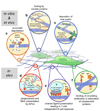Modular self-assembling biomaterials for directing cellular responses
- PMID: 20198120
- PMCID: PMC2829887
- DOI: 10.1039/b805563g
Modular self-assembling biomaterials for directing cellular responses
Abstract
Self-assembling biomaterials are promising as cell-interactive matrices because they can be constructed in a modular fashion, which enables the independent and simultaneous tuning of several of their physicochemical and biological properties. Such modularity facilitates the optimization of multi-component matrices for use in complex biological environments such as 3-D cell culture or scaffolds for regenerative medicine. This Highlight will discuss recent strategies for producing modular self-assembling biomaterials, with a particular focus on how ligand presentation and matrix mechanics can be controlled in modular ways. In addition, it will discuss key hurdles that remain for employing these materials as cell-interactive scaffolds in biomedical applications, particularly those that relate to how they may interface with the immune system.
Figures



References
-
- Lutolf MP, Hubbell JA. Nat Biotechnol. 2005;23:47–55. - PubMed
-
- Mart RJ, Osborne RD, Stevens MM, Ulijn RV. Soft Matter. 2006;2:822–835. - PubMed
-
- Segers VFM, Lee RT. Drug Discovery Today. 2007;12:561–568. - PubMed
-
- Deming TJ. Progress in Polymer Science. 2007;32:858–875.
- MacPhee CE, Woolfson DN. Current Opinion in Solid State & Materials Science. 2004;8:141–149.
- Hamley IW. Angewandte Chemie-International Edition. 2007;46:8128–8147. - PubMed
-
- Channon K, MacPhee CE. Soft Matter. 2008;4:647–652. - PubMed
Grants and funding
LinkOut - more resources
Full Text Sources
Other Literature Sources

